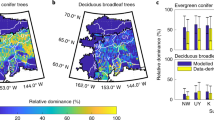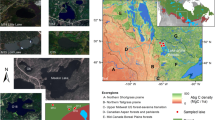Abstract
Changes in climate, atmospheric carbon dioxide concentration and fire regimes have been occurring for decades in the global boreal forest1,2,3, with future climate change likely to increase fire frequency4—the primary disturbance agent in most boreal forests3,5. Previous attempts to assess quantitatively the effect of changing environmental conditions on the net boreal forest carbon balance have not taken into account the competition between different vegetation types on a large scale6,7,8,9. Here we use a process model with three competing vascular and non-vascular vegetation types to examine the effects of climate, carbon dioxide concentrations and fire disturbance on net biome production, net primary production and vegetation dominance in 100 Mha of Canadian boreal forest. We find that the carbon balance of this region was driven by changes in fire disturbance from 1948 to 2005. Climate changes affected the variability, but not the mean, of the landscape carbon balance, with precipitation exerting a more significant effect than temperature. We show that more frequent and larger fires in the late twentieth century resulted in deciduous trees and mosses increasing production at the expense of coniferous trees. Our model did not however exhibit the increases in total forest net primary production that have been inferred from satellite data1,10. We find that poor soil drainage decreased the variability of the landscape carbon balance, which suggests that increased climate and hydrological changes have the potential to affect disproportionately the carbon dynamics of these areas. Overall, we conclude that direct ecophysiological changes resulting from global climate change have not yet been felt in this large boreal region. Variations in the landscape carbon balance and vegetation dominance have so far been driven largely by increases in fire frequency.
This is a preview of subscription content, access via your institution
Access options
Subscribe to this journal
Receive 51 print issues and online access
$199.00 per year
only $3.90 per issue
Buy this article
- Purchase on Springer Link
- Instant access to full article PDF
Prices may be subject to local taxes which are calculated during checkout



Similar content being viewed by others
References
Goetz, S. J. et al. Satellite-observed photosynthetic trends across boreal North America associated with climate and fire disturbance. Proc. Natl Acad. Sci. USA 102, 13521–13525 (2005)
Gillett, N. P. et al. Detecting the effect of climate change on Canadian forest fires. Geophys. Res. Lett. 31 L18211 doi: 10.1029/2004GL020876 (2004)
Stocks, B. J. et al. Large forest fires in Canada, 1959–1997. J. Geophys. Res. 108 8149 doi: 10.1029/2001JD000484 (2003)
Watson, R. T. et al. The Regional Impacts of Climate Change. An Assessment of Vulnerability (Cambridge Univ. Press, Cambridge, UK, 1998)
Zimov, S. A. et al. Contribution of disturbance to increasing seasonal amplitude of atmospheric CO2 . Science 284, 1973–1976 (1999)
Balshi, M. S. et al. Role of historical fire disturbance in the carbon dynamics of the pan-boreal region: a process-based analysis. J. Geophys. Res. 112 G02029 doi: 10.1029/2006JG000380 (2007)
Peng, C. & Apps, M. J. Modelling the response of net primary productivity (NPP) of boreal forest ecosystems to changes in climate and fire disturbance regimes. Ecol. Modell. 122, 175–193 (1999)
Kang, S., Kimball, J. S. & Running, S. W. Simulating effects of fire disturbance and climate change on boreal forest productivity and evapotranspiration. Sci. Tot. Environ. 362, 85–102 (2006)
Kasischke, E. S., Christensen, N. L. J. & Stocks, B. J. Fire, global warming, and the carbon balance of boreal forests. Ecol. Appl. 5, 437–451 (1995)
Nemani, R. R. et al. Climate-drive increases in global terrestrial net primary production from 1982 to 1999. Science 300, 1560–1563 (2003)
Running, S. W. & Coughlan, J. C. A general model of forest ecosystem processes for regional applications. I. Hydrological balance, canopy gas exchange and primary production processes. Ecol. Modell. 42, 125–154 (1988)
Bond-Lamberty, B. et al. Reimplementation of the BIOME-BGC model to simulate successional change. Tree Physiol. 25, 413–424 (2005)
Chapin, F. S. et al. Reconciling carbon-cycle concepts, terminology, and methods. Ecosystems 9, 1041–1050 (2006)
Running, S. W. & Gower, S. T. FOREST-BGC, A general model of forest ecosystem processes for regional applications. II. Dynamic carbon allocation and nitrogen budgets. Tree Physiol. 9, 147–160 (1991)
Bond-Lamberty, B., Gower, S. T. & Ahl, D. E. Improved simulation of poorly drained forests using Biome-BGC. Tree Physiol. 27, 703–715 (2007)
Bond-Lamberty, B. et al. Simulation of boreal black spruce chronosequences: comparison to field measurements and model evaluation. J. Geophys. Res. 111 G02014 doi: 10.1029/2005JG000123 (2006)
Amthor, J. S. et al. Boreal forest CO2 exchange and evapotranspiration predicted by nine ecosystem process models: Intermodal comparisons and relationships to field measurements. J. Geophys. Res. D 106, 33623–33648 (2001)
Kurz, W. A. & Apps, M. J. A 70-year retrospective analysis of carbon fluxes in the Canadian forest sector. Ecol. Appl. 9, 526–547 (1999)
Li, Z. et al. Temporal changes of forest net primary production and net ecosystem production in west central Canada associated with natural and anthropogenic disturbances. Can. J. For. Res. 33, 2340–2351 (2003)
Amiro, B. D. et al. Direct carbon emissions from Canadian forest fires, 1959–1999. Can. J. For. Res. 31, 512–525 (2001)
Harden, J. W. et al. The role of fire in the boreal carbon budget. Glob. Change Biol. 6 (Suppl. 1). 174–184 (2000)
Kasischke, E. S. & Bruhwiler, L. P. Emissions of carbon dioxide, carbon monoxide, and methane from boreal forest fires in 1998. J. Geophys. Res. 108 8146 doi: 10.1029/2001JD000461 (2003)
Harden, J. W. et al. Dynamics of soil carbon during deglaciation of the Laurentide ice sheet. Science 258, 1921–1924 (1992)
Deng, F. et al. Global monthly CO2 flux inversion with a focus over North America. Tellus B 59, 179–190 (2007)
Hicke, J. A. et al. Satellite-derived increases in net primary productivity across North America, 1982–1998. Geophys. Res. Lett. 29 1427 doi: 10.1029/2001GL013578 (2002)
Zhou, L. et al. Variations in northern vegetation activity inferred from satellite data of vegetation index during 1981 to 1999. J. Geophys. Res. D 106, 20069–20083 (2001)
Hicke, J. A. et al. Postfire response of North American boreal forest net primary productivity analyzed with satellite observations. Glob. Change Biol. 9, 1145–1157 (2003)
Litvak, M. et al. Effect of stand age on whole ecosystem CO2 exchange in the Canadian boreal forest. J. Geophys. Res. D 108 8225 doi: 10.1029/2001JD000854 (2003)
Flannigan, M. D. & Van Wagner, C. E. Climate change and wildfire in Canada. Can. J. For. Res. 21, 66–72 (1991)
R Development Core Team. R: A language and environment for statistical computing. (R Foundation for Statistical Computing, Vienna, 2006)
Acknowledgements
This research was supported by National Aeronautics and Space Administration and National Science Foundation (Integrated Research Challenges in Environmental Biology) grants to S.T.G. Biome-BGC version 4.1.2 was provided by the Numerical Terradynamic Simulation Group (NTSG) at the University of Montana; NTSG assumes no responsibility for the proper use of Biome-BGC by others. This study would not have been possible without the assistance of D. Luke.
Author Contributions S.T.G., B.B.-L. and D.E.A. designed the experiment. S.D.P. and D.E.A. assembled input data, and B.B.-L. and S.D.P. wrote code, ran the model, and analysed output data. B.B.-L. administered the experiment and wrote the manuscript.
Author information
Authors and Affiliations
Corresponding author
Ethics declarations
Competing interests
The authors declare no competing financial interests.
Supplementary information
Supplementary Information
The file contains Supplementary Notes, Supplementary Figures S1-S2, Supplementary Table S1 and additional references. This document gives a full map of the study area, maps of input data, a table summarizing meteorological input data used, and references to studies appearing in Figure 3 of the main text. (PDF 2103 kb)
Rights and permissions
About this article
Cite this article
Bond-Lamberty, B., Peckham, S., Ahl, D. et al. Fire as the dominant driver of central Canadian boreal forest carbon balance. Nature 450, 89–92 (2007). https://doi.org/10.1038/nature06272
Received:
Accepted:
Issue Date:
DOI: https://doi.org/10.1038/nature06272
This article is cited by
-
Post-fire stabilization of thaw-affected permafrost terrain in northern Alaska
Scientific Reports (2024)
-
Black spruce (Picea mariana) seed availability and viability in boreal forests after large wildfires
Annals of Forest Science (2023)
-
Terrestrial carbon dynamics in an era of increasing wildfire
Nature Climate Change (2023)
-
Global scale coupling of pyromes and fire regimes
Communications Earth & Environment (2023)
-
Shifts in Ecological Legacies Support Hysteresis of Stand Type Conversions in Boreal Forests
Ecosystems (2023)
Comments
By submitting a comment you agree to abide by our Terms and Community Guidelines. If you find something abusive or that does not comply with our terms or guidelines please flag it as inappropriate.



